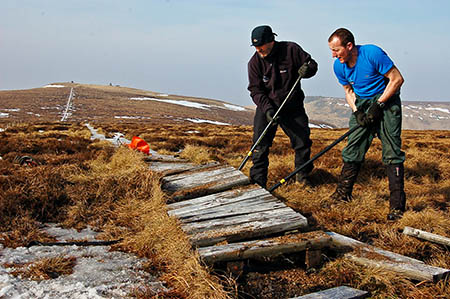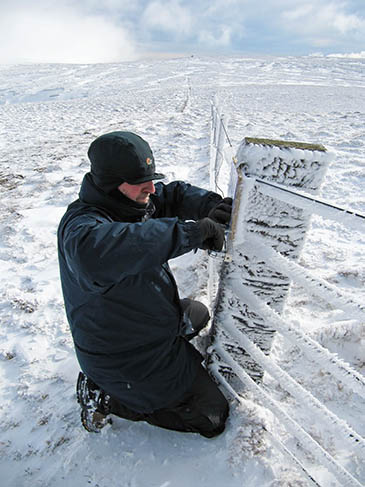Parts of the northernmost section of Britain’s first national trail will be on a firmer footing after work to repair the route.
Northumberland National Park Authority is laying ‘floating’ recycled sandstone flags on the Pennine Way around the Scottish border.
The work, part of a £160,000 project, will help walkers nearing the end of the 431km (268-mile) long-distance path, the first to be established in Britain in 1965.
More than a kilometre of footpaths, some of which currently have boardwalks, are being upgraded in the Northumberland Cheviot Hills.
Natural England, the Westminster Government’s advisory body for the outdoors in England, provided cash for the work.
The old mill flags float on the vegetation providing a firm walking surface and preventing further erosion of the peat. The funds will also enable the hundreds of tonnes of stone to be airlifted onto the Border Ridge, where there is no vehicle access, and to hire local contractors to help put the flags in place.
Work on a 1,000m section of the trail at Auchope Cairn and a further 60m at Wedder Hill are now underway, and will be followed by further work on the section of the route at Padon Hill in Redesdale.
The park authority said it is a challenge for the ranger team working at this height and getting people and equipment to such a remote area. The weather conditions at this time of year have been unpredictable with snow lying and frozen ground.
The upgrades to the Pennine Way are part of a continuous improvement programme by the national park authority when funds allow.
In places the boardwalk has become slippery and flags have sunk in particularly wet areas, making repairs urgent. Rights of way officer Lorna Lazzari said: “We’re delighted at last to have the funds to make these vital upgrades to the national trail.
“When footpaths become waterlogged, people will naturally divert off the path onto the fragile vegetation, which results in large patches of erosion along well used routes and much greater damage to both the peat soils and the footpath.
“This part of the Pennine Way has long, challenging stretches between shelter and accommodation, but during the dry summers the going is relatively easy.
“With so much rainfall recently, it has been both uncomfortable and distracting for walkers forging through a stretch to enjoy some of the finest views in the Borders.”
The UK’s national parks share experience and tested techniques for maintaining and improving footpaths to provide the best walking conditions while protecting the natural environment, the Northumberland authority said.
When funding permits, it is acknowledged best practice for heritage and wildlife conservation to provide a sustainable walking surface that can cope with traffic and weather conditions rather than to drain naturally wet areas or divert footpaths.
Most national trails pass through internationally significant nature conservation areas as well as the outstanding landscapes of national parks and areas of outstanding natural beauty.
The Cheviot Hills with their upland peat bogs are an important water catchment area and feed the most pristine rivers in the country.
Northumberland national park contains some of the best bogs in Europe and are largely untouched by human activities as they have slowly built up in cool wet conditions over 10,000 years.
The high hills of the Cheviots have been covered by blanket bog which is an important carbon store.
Plants growing there include cloudberry and crowberry as well as sphagnum mosses, sundew, bog rosemary and cotton grass in a patchwork with heather and bilberry.
They form a habitat for invertebrates such as the emperor moth and mountain bumblebee and for nesting wading birds such as the curlew.


Kevin Futers
19 March 2013This is a subject close to my heart as I made footpath erosion on this stretch of the Pennine Way my dissertation subject back in 1990/91. At that time the boardwalks were only a few years old and there had been vegetation surveys taken across the route before and after. I followed this up with my own survey (thankfully the posts from the original survey were still in place, and the methodology was clear and easy to replicate).
My recommendations then were for something a little less intrusive on the landscape than boardwalks, and subsequent work has involved the use of stone flags, as can be seen, for example, across the Simonside Hills, where a heavily eroded clifftop footpath has been abandoned and a new flagged route has been laid across the hilltops.
I have to say that the result is not always the most sympathetic in the landscape, but knowing how fragile our moorland ecology is, it has to be better than a four metre wide swathe of trammelled bog.